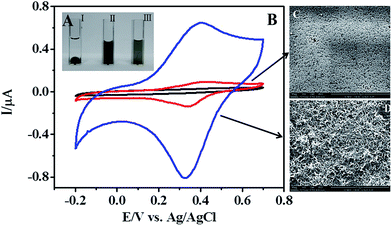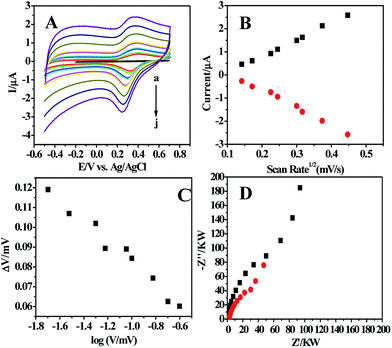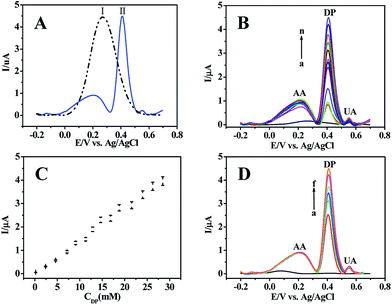A new strategy for detecting dopamine in human serum using polymer brushes reinforced with carbon nanotubes
Lucas C. Recco,
Bruno P. Crulhas,
João P. R. L. L. Parra and
Valber A. Pedrosa*
Department of Chemistry and Biochemistry, Institute of Bioscience, UNESP, Botucatu, SP, Brazil. E-mail: vpedrosa@ibb.unesp.br
First published on 9th May 2016
Abstract
Direct detection of dopamine (DA) in serum samples without any type of extraction or pre-treatment has been a great challenge for biomedical analysis. This paper reports the development of a sensor consisting of polymer brushes reinforced with multi-walled carbon nanotubes, that was used to determine levels of dopamine in human blood serum. The structure and morphology of the as-prepared hybrid nanomaterials were characterized and confirmed by scanning electron microscopy and electrochemistry techniques. This methodology employs differential pulse voltammetry to detect dopamine in human serum samples at concentrations ranging from 0.1 μM to 10 μM with an obtained detection limit of 40.5 nmol L−1 (R = 0.996). This sensor provides an inexpensive and easy-to-use device with high degrees of sensitivity and selectivity for monitoring DA in human blood serum samples.
Dopamine (DA) is one of the most important neurotransmitters in the central nervous system, including the brain.1 It also plays key roles in regulating the renal, hormonal, and cardiovascular systems.2 Low amounts of dopamine can interfere with normal physiological processes, and induce Parkinson's disease. As a result, there is great interest in developing new ways of detecting dopamine by using advanced analytical methods. Various methodologies including immunoassays,3 spectrophotometry4 and chromatographic techniques have been used for this purpose.5 While these methods are highly sensitive and accurate for detecting DA, they require expensive and sophisticated instruments, involve multiple steps, and are time consuming to perform.
Recently, new electromaterials have attracted attention for their high effectiveness in detecting target analytes, and ability to provide a strong electronic signal output. Carbon nanotubes (CNTs) have been used in nanoelectronic and photovoltaic devices,6 superconductors,7 electrochemical capacitors,8 nanowires,9 and nanocomposite materials,10 and also serve as reinforcing agents in polymer composites.11 Some properties of polymer composites that can be improved by the presence of CNTs include tensile strength, tensile modulus, toughness, optical properties, and electrical conductivity.12 The most crucial step in preparing a CNT–polymer is the efficient dispersion of CNTs throughout the polymer matrix. Physical absorption is an efficient method for modifying CNTs, and is achieved via the hydrophobic interaction of several repeating phenyl ring units with the CNT surface. However, the bonding strength of this hydrophobic interaction is weaker than that of a chemical bond.13,14 Thus the development of simple and versatile CNT coating methods that do not damage the CNT sidewalls remains an ongoing challenge for researchers.
Here, we propose a new method for the direct detection of DA. This method uses polymer brushes that are reinforced with multi-walled carbon nanotubes (MWNTs). This newly developed sensor demonstrated high sensitivity and selectively, as well as good reproducibility when used for detecting DA in human blood serum.
Poly(Vinyl Imidazole) (PVI) was purchased from Polymer Source. Multi-walls carbon nanotubes (MWNTs), dopamine, sulfuric acid (98% H2SO4), nitric acid (60% HNO3), ethylene glycol, hexadecytrimethyl–ammonium bromide (MW 364.45), toluene, ethanol, ammonium hydroxide, butanone, hydrogen peroxide, 3-glycidyloxypropyl trimethoxysilane (MW 236.34), oxide titanium indium (ITO) and ferrocene monocarboxylic acid (FcMA) were bought from Sigma-Aldrich (St. Louis, USA). Phosphate buffer (PBS) 10 mM was used as an electrolyte for all electrochemistry experiments. Water used for preparation of all aqueous solutions came from a Millipore Direct-Q water purification system (resistivity, 18 MΩ cm−2).
All electrochemical measurements were performed at room temperature with a potentiostat μAutoLabIII (Metrohn, NL). Our system contains a working electrode (PVI–MWNTs), a reference electrode (Ag/AgCl (3 M KCl), and a platinum wire counter electrode. All the measurements were carried out individually at least three times, and error bars are displayed in the following figures. Electrochemical impedance spectroscopy (EIS) was performed at an amplitude of 0.005 V in the presence of 10 mM PBS solution containing 0.05 mM FcMA.
Dopamine detection was done using differential pulse voltammetry with potential ranging from 0.3 to 0.8 V. Calibration curve was constructed by ploting absolute value for current at 0.6 V versus dopamine concentration.
The ITO electrodes were chemically modified with PVI–MWNTs brushes using the grafting-to method according to the following procedure.15,16 PVI–MWNTs solution was mixed and added onto ITO for reaction with epoxy group and spread using a spin coater. The process of adsorption of hybrid film onto ITO was realized in oven the vacuum at 140° degrees for 4 h and after washed with ethanol. Characterization of surface was done by scanning electron microscopy (SEM) images taken with a Quanta200 (FEI company, USA) field-emission scanning electron microscope operating at an acceleration voltage of 20 kV.
Raw MWNTs are hydrophobic and difficult to produce as a uniform dispersion in an aqueous medium (Fig. 1A). To make this process easier, a suspension containing 5 mg of MWNTs were mixed with polyvinylimidazole (PVI) to form a well dispersed solution that remained stable for >3 months, and showed no evidence of precipitation (Fig. 1A). Finally, uniform film of PVI–MWNTs was produced by dispersions onto an indium tin oxide (ITO) electrode. Scanning electron micrograph (SEM) images of the PVI and PVI–MWNTs samples are shown in Fig. 1C and D, respectively, and indicate that the dispersions formed of a thin film. We hypothesized that addition of MWNTs should improve the conductivity of PVI. To test this hypothesis, the properties of an electrode functionalized with MWNTs were characterized by cyclic voltammetry. Fig. 1B shows cyclic voltammograms of PVI and PVI–MWNTs-modified electrodes as recorded in the presence of 0.05 mM of FcMA in 10 mM of PBS buffer. The cyclic voltammograms show that oxidation and reduction peaks occurred at 0.4 V and 0.33 V, respectively.
Correlations between redox peak currents and scan rates in presence of dopamine are shown in Fig. 2A. The redox peak current of PVI–MWNTs–ITO current gradually increased in presence of dopamine, indicating a electroactive sensor for DA detection. Peak current measurements in the range of 20 to 250 mV s−1 were proportional to the square root of the scan rate (υ1/2), indicating that the crucial step in the reaction was a diffusion-controlled process (Fig. 2B). To better understand this process, the reaction mechanism was analyzed by plotting the peak potential versus the scan rate. The peak-to-peak (ΔEp) separation remained constant up to 60 mV, suggesting that a reversible electrochemical process was occurring on a confined surface (Fig. 2C).
To corroborate our cyclic voltammetric results, the nanocomposite material was analyzed by electrochemical impedance spectroscopy (EIS), with measurements being performed in the presence of a redox agent (FcMA). The diameter of the semicircle represents the charge-transfer resistance (Rct) at the electrode surface. Fig. 2D compares the electrochemical impedance spectra (Nyquist plots, Z′′ vs. Z′) in the presence and absence of MWNTs. The diameter of the semicircle represents the charge-transfer resistance (Rct) at the electrode surface. As shown in Fig. 2D, the diameter of the semicircle, indicating the corresponding Rct, decreased as the number of layers increased. The diameter of the semicircle, which corresponds to Rct, decreased in presence of MWNTs, suggesting that MWNTs facilitate electron transfer through the film. The calculated values of charge transfer resistance were ∼60 kΩ PVI/ITO prior to modification with MWNTs (black line) and ∼40 kΩ PVI/ITO after modification with MWNTs (red line) (Fig. 2D). These results prove that addition of carbon nanotubes to the polymeric matrix improved the conduction of electrons.
As the oxidation peaks observed for uric acid, ascorbic acid and dopamine were close enough to overlay, a unique peak current is obtained in simultaneous determinations (Fig. 3A, I). Thus, the excellent electrocatalytic activity of MWNTs reinforced on the polymer matrix provides a robust basis for simultaneous determination of DA, AA and UA by separation of each oxidation peak. It can be observed that the mixing solution with only PVI presented a unique broad anodic peak in presence of DA, UA and AA at the potential of 0.28 V (Fig. 3A, I). However, PVI/MWNTs electrode shows a separate peak potential values for each biomolecule, as shown in Fig. 3A, II, by three well defined peaks located at 0.2 for AA, 0.4 V for DA, and 0.52 V for UA. In this way, the proposed methodology seems to be appropriate to carry out simultaneous determination of DA in presence of well-known interfering compounds like uric acid and ascorbic acid.
In order to expand the procedure and analyze its validity in DA determination, the same procedure was applied keeping known concentration of UA and AA (100 mM), but varying the concentrations of DA. Fig. 3B shows the increasing concentrations of DA in the presence of 100.0 mmol L−1 UA and 100 mmol L−1 of AA. No change was observed in either the UA or AA oxidation current, indicating a relatively independent response to DA. The peak current increased in a linear manner with increasing DA concentrations, and the correlation coefficient was 0.998. The lowest detectable concentration of dopamine was 2 μM and linear response range was 2 μM to 30 μM. These results showed that the sensor was robust, and could be used to reliably detect levels of dopamine found in actual clinical samples. The long-term stability of the sensor response was evaluated by making repeated injections of DA over a ∼3 h time period. Measurements were made using two different DA concentrations (2.0 and 5.0 μmol L−1), at an electrical potential of 0.4 V. Our results showed an excellent stable response throughout the 3 h time period, with maximum RSD values of 4.5% and 2.0% at DA concentrations of 2.0 μmol L−1 and 5.0 μmol L−1, respectively. A comparison of the analytical results obtained using our direct sensor with results obtained using the methodologies currently available for detecting DA demonstrate our capability of DA detection in presence of two major interfering compounds (AA and UA), when most of biosensors only detected in the presence of UA (Table 1). Furthermore, the limit of detection of our sensor was at nanomolar level range which is a similar concentration found in human body.23 Moreover, our device requires a few steps for fabrication and it is a ready do use device without requiring pretreatment of samples when compared to different techniques.20,22
We next used our method to detect DA levels in actual serum samples to demonstrate its practical application by mimicking biological fluid where DA, AA and UA can coexist, being a trial test to produce point-of-care blood analysis for DA. The serum samples were provided by Profa. Dra. Vera Rall of Department of Microbiology and Immunology, Institute of Bioscience, UNESP, Botucatu, SP, Brazil. The results showed that our sensor was capable of detecting dopamine in human serum samples. Briefly, a 10% serum solution was placed into the electrochemical cell, and electrochemical detection was verified by DPV performed in the presence of ascorbic acid and uric acid (Fig. 3C). The linear relationship between Ip and [DA] can be described by Ipa = 0.002 mA + 0.20 mA mmol−1 L−1 [DA], and the correlation coefficient was 0.996. The detection limit (S/N = 3) for DA was 40.5 nmol L−1, and was determined using a 3s/slope ratio, where s is the standard deviation of the mean value for 10 voltammograms of the blank, as determined according to IUPAC recommendations.
The electrode performed exceptionally well when used to detect DA in serum samples, even at concentrations as low as 2.0 μM. In a subset of these measurements, the current reached a peak immediately after each addition of DA. These results prove that AA and UA did not interfere with either DA oxidation or electron transfer on the surface of the electrode. We attribute this to the effective and efficient catalytic properties of the electrode, and the selectivity of PVI/MWCNTs for DA oxidation at a specific voltage. When compared with similar sensors described in the literature, our sensor was able to detect dopamine in complex samples, as well as in the presence of interfering compounds (Table 1). Furthermore, our detection method displayed high stability and sensitivity, as well as a suitable lower limit of detection. Finally, our DA detection method does not involve any sample pre-treatment or dilution steps, and thus represents the fastest and least expensive means of detecting DA with high degrees of sensitivity and selectivity.
Conclusions
PVI/MWNTs were adsorbed onto ITO substrate by grafting to method. The novel polymer brush (PVI/MWNTs/ITO) enabled simultaneous analysis of DA, AA and UA in phosphate buffer solution (pH 7.0) and human serum by DPV technique due to catalytic effect of polymer brushes reinforced with MWNTs three well defined oxidation peak were obtained for DA, AA, and UA, allowing simultaneous analysis in a single measurement. Moreover, the detection ability of PVI/MWNTs/ITO displayed high stability and sensitivity, as well as a suitable limit of detection for human body fluids, so our findings demonstrate that the modification of PVI/MWNTs/ITO enhances significantly the direct DA detection in real samples without needing any pre-treatment or dilution steps, and thus represents the fastest and least expensive means of detecting DA with high degrees of sensitivity and selectivity being a powerful sensor for future application in point-of-care blood analysis.Acknowledgements
We gratefully acknowledge partial support by grants from the FAPESP (2014/05653-5), CNPq and CAPES.References
- J. Zhao, Y. Yu, B. Weng, W. Zhang, A. T. Harris, A. I. Minett, Z. Yue and X. F. Huang, Electrochem. Commun., 2013, 37, 32–35 CrossRef CAS
.
- J. M. Savitt, V. L. Dawson and T. M. Dawson, J. Clin. Invest., 2006, 116, 1744–1754 CAS
.
- S. Shi, L. Wang, R. Su, B. Liu, R. Huang, W. Qi and Z. He, Biosens. Bioelectron., 2015, 74, 454–460 CrossRef CAS PubMed
.
- B. Verastegui-Omaña, M. Palomar-Pardavé, A. Rojas-Hernández, S. C. Avendaño, M. Romero-Romo and M. T. Ramírez-Silva, Spectrochim. Acta, Part A, 2015, 143, 187–191 CrossRef PubMed
.
- D. Zhang, L. Wu, D. S. Chow, V. H. Tam and D. R. Rios, J. Pharm. Biomed. Anal., 2016, 117, 227–231 CrossRef CAS PubMed
.
- A. Bachtold, P. Hadley, T. Nakanishi and C. Dekker, Science, 2001, 294, 1317–1320 CrossRef CAS PubMed
.
- A. Y. Kasumov, R. Deblock, M. Kociak, B. Reulet, H. Bouchiat, I. I. Khodos, Y. B. Gorbatov, V. T. Volkov, C. Journet and M. Burghard, Science, 1999, 284, 1508–1511 CrossRef CAS PubMed
.
- C. Niu, E. K. Sichel, R. Hoch, D. Moy and H. Tennet, Appl. Phys. Lett., 1997, 70, 1480–1482 CrossRef CAS
.
- P. M. Ajayan and S. Iijima, Nature, 1993, 361, 333–334 CrossRef CAS
.
- X. L. Xie, Y. W. Mai and X. Ping, Mater. Sci. Eng., R, 2005, 49, 89–112 CrossRef
.
- P. M. Ajayan, O. Stephan, C. Colliex and D. Trauth, Science, 1994, 265, 1212–1214 CAS
.
- J. Y. Kim, S. I. Han and S. H. Kim, Polym. Eng. Sci., 2007, 47, 1715–1723 CAS
.
- N. G. Sahoo, S. Rana, J. W. Cho, L. Li and S. H. Chan, Prog. Polym. Sci., 2010, 35, 837–867 CrossRef CAS
.
- H. Hu, B. Yu, Q. Ye, Y. Gu and F. Zhou, Carbon, 2010, 48, 2347–2353 CrossRef CAS
.
- T. R. T. Antonio, M. F. Cabral, I. Cesarino, S. A. Machado and V. A. Pedrosa, Electrochem. Commun., 2013, 29, 41–44 CrossRef CAS
.
- X. Lou, C. Detrembleur, C. Pagnoulle, R. Jérôme, V. Bocharova, A. Kiriy and M. Stamm, Adv. Mater., 2004, 16, 2123–2127 CrossRef CAS
.
- H. S. Han, H. K. Lee, J. M. You, H. Jeong and S. Jeon, Sens. Actuators, B, 2014, 190, 886–895 CrossRef CAS
.
- D. Zhao, G. Yu, K. Tian and C. Xu, Biosens. Bioelectron., 2016, 82, 119–126 CrossRef CAS PubMed
.
- N. G. Tsierkezos, S. H. Othman, U. Ritter, L. Hafermann, A. Knauer, J. M. Köhler, C. Downing and E. K. McCarthy, Sens. Actuators, B, 2016, 231, 218–229 CrossRef CAS
.
- L. Zhu, G. Xu, Q. Song, T. Tang, X. Wang, F. Wei and Q. Hu, Sens. Actuators, B, 2016, 231, 506–512 CrossRef CAS
.
- C. Lete, S. Lupu, B. Lakard, J. Y. Hihn and F. J. del Campo, J. Electroanal. Chem., 2015, 744, 53–61 CrossRef CAS
.
- L. Tang, S. Li, F. Han, L. Liu, L. Xu, W. Ma, H. Kuang, A. Li, L. Wang and C. Xu, Biosens. Bioelectron., 2015, 71, 7–12 CrossRef CAS PubMed
.
- A. Gardner and D. Shoback, LANGE Clinical Medicine, McGraw Hill, 9th edn, 2011, p. 880 Search PubMed
.
| This journal is © The Royal Society of Chemistry 2016 |



